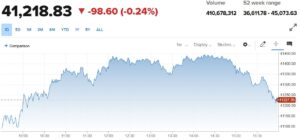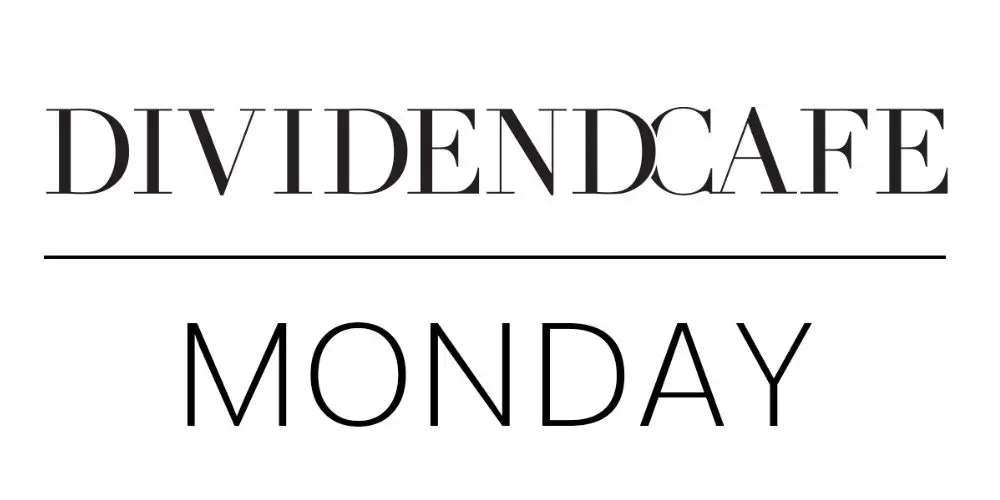Dear Valued Clients and Friends –
It is a very, very full Dividend Cafe today, with a lot to say on markets, and a lot to say on Public Policy. This is what you get when you leave me by myself in the city for the weekend with a laptop, a President tweeting and interviewing like crazy, and a pile of reading to take in. I believe you will find today’s Dividend Cafe worth the price you paid.
Dividend Cafe on Friday did a deeper dive into the state of the economy, unpacked the Q1 GDP report, and laid out where the U.S. stands economically, and where China stands, and what it all means for investors. The written version is here (my favorite), the video is here, and the podcast is here.
Off we go …
|
Subscribe on |
Market Action
- The market opened down -200 points and improved throughout the first half of the day, then dropped in the last hour of the day
- The Dow closed down -99 points (-0.24%) with the S&P 500 down -0.64% and the Nasdaq -0.74%.

*CNBC, DJIA, May 5, 2025
- I think I am pretty much on record with how worthless I think technical market indicators are, and in fact, just sharing them now reinforces their worthlessness … The market is, indeed, above its 50-day moving average – but if that was some sort of positive indicator, presumably it would have been a really negative one when it collapsed below its 50-day moving average a month ago. These things are all true, until they aren’t, which is a cutesy way of saying they aren’t predictively valuable, and also that the sky is blue. So if you hear talk of the S&P getting above its 200-day moving average in the days ahead (it hasn’t done so yet), it is true that after the S&P gets above its 200-day average, it will either go up or go down. You heard it here first.
- Along those lines, I have gotten more questions lately as to whether or not it is possible this recent recovery is just a “bear market rally” … To which I say, “Of course.” But it is hard to understand what any of this means. What label you put on a long-term, properly-constructed portfolio, in the midst of day-to-day uncertainty, strikes me as pretty cosmetic (and irrelevant). And eventually, we get to put descriptive labels on market cycles with certain accuracy because we are describing what actually happened with 20/20 vision. The terms get used in different ways to describe different things. What I believe is the following:
- A sell-off in a bull market or a rally in a bear market are all irrelevant in the present tense, and only become clear when you have the gift of hindsight, later.
- Most screaming, clear-as-day, secular bull markets (long-term periods of both earnings expansion and multiple expansion where market prices meaningfully move higher) are followed by multi-year periods of range-bound markets. By “most,” I mean “all,” in terms of history.
- Dividend growth investors love periods like this
- Dividend growth investors love all other periods, too
- And ultimately, if you believe in the tenets of the profit motive, self-interest, human ingenuity, incentives, and free enterprise, with the right timeline, it’s all a bull market.
- The ten-year bond yield closed today at 4.34%, up two basis points on the day.
- The 10-year was 4.57% on the day of the inauguration, hit 4.65% a couple of days later, and was 4.23% after a hundred days. Additionally, the 2/10 curve steepened by 30 basis points (that is, the 10-year came down by 30bps, but the 2-year came down by 60bps, a much healthier yield curve, indeed).
- Top-performing sector for the day: Consumer Staples (+0.02%) – only positive sector was basically flat
- Bottom-performing sector for the day: Energy (-2.02%)
- If you’re looking for something to be bearish about for index investors, besides a 21x forward multiple on a questionable earnings picture, while trade has come to a standstill with our second-largest trading partner, I would consider the flows. In other words, retail investors were buying the dip throughout April, and psychology seems consistently bullish. This makes contrarians wonder …
- A big exception to the flows from U.S. retail investors – foreign investors. Foreign flows into U.S. bond and stock ETFs and mutual funds have gone decidedly negative.
- How volatile was April? If you take intra-day volatility (the intraday high minus the intraday low divided by the prior day’s close), it was higher than the March 2020 COVID crash, and matched only by the Sept/Oct 2008 GFC and the 1987 Crash.
Public Policy
- The Trump administration’s budget blueprint came out Friday. It cuts $163 billion from discretionary spending (a 23% reduction), adds to military spending, and does not touch entitlements at all.
- Skepticism is growing that Speaker Johnson can deliver a reconciliation bill by Memorial Day, even as optimism is growing that some bill will get approved in the months ahead.
- I will say that futures took a second leg down last night when the President tweeted out that he was imposing a 100% tariff on any movie made overseas, discussing the “unfairness” of other countries offering tax breaks for movies to be made in their home turf. I do not think markets much care about the specifics of where movies are made, but rather the re-surfacing of rather strong protectionism, unpredictability, and substantially arbitrary executive action reinforced the risk premium just as markets were beginning to accept some degree of off-ramping.
- On May 13, the United States Court of International Trade will hear arguments wherein a consortium of small businesses has asked for an injunction preventing the executive branch from using national security as the pretextual basis for passing tariffs. A ruling against the administration would likely be headed to the Supreme Court, and the administration plans to switch rationales for various tariffs as circumstances warrant. My own read is that some successful blockage of the way the administration has done things is possible, but will mostly prove to be whack-a-mole as things move around, regardless. I will be surprised if legal objections end up fully nullifying all of the White House efforts, but I do believe some will prevail on the merits, and some will at least create delays, which may buy time as this whole thing continues to shake out.
- My sources tell me that a “trade deal” with India is likely to be announced this week, focusing less on tariff rates and more on purchase commitments and curbs on other barriers.
Economic Front
- The April jobs report showed 177,000 jobs created in April, at first glance higher than expected, but with downward revisions the last couple of months, about in line with forecasts. But the household survey and the labor participation force were solid, so it has to be taken as a pretty solid monthly print.
- The surprise to me was only 9,000 jobs shed in government – this doesn’t seem to match the hype we have heard about DOGE cuts so I want to look for more follow-up in the governmental data.
- I thought this chart from Torsten Slok of Apollo was noteworthy, especially in light of President Trump’s comments that kids might only need two dolls this year versus thirty …

- 76% of manufacturing companies in the newest FRB Survey said they will pass on the costs of tariffs to customers. I would suggest that 24% are lying.
Housing & Mortgage
- The April CMBS Delinquency report (Commercial Mortgage Backed Securities) showed a 0.38% increase in overall delinquencies (7.03%). But more noteworthy – the multi-family delinquencies jumped 113bps to 6.57% and the lodging delinquencies jumped 66bps to 7.85%.
Federal Reserve
- As the FOMC prepares to meet tomorrow, odds are basically 100% that there will be no rate move this week. Surprisingly, futures are all the way up to 68% that there will also be no rate move at the June meeting (not likely to make the President very happy)
- 3-4 rate cuts is now the most probable range by year-end
- The Powell presser on Wednesday this week is more likely to make waves than anything the FOMC actually does or even says in the Wednesday announcement.
Oil and Energy
- WTI Crude closed at $57, down -2.2% on the day.
- Energy lagged last week as a 2.9% up week in the stock market came with a 7.5% drop in crude oil prices and a 1% drop in the midstream energy sector.
- I was taken by this quote from Hinds Howard, the Energy and Infrastructure Portfolio Manager at CBRE Clarion:
“I continue to believe midstream companies are better positioned financially today than at any other point in the last 30 years I’ve covered the space. There are fewer, larger players with lower payout ratios, lower leverage and fewer large projects in the queue. The upstream customers of midstream companies are also healthier, larger and more organized than at any point in 15 years.”
Hinds is one of the most sober-minded, judicious, thorough, and thoughtful PMs and analysts of the midstream space out there (I have read him diligently for over ten years), and this is a profoundly important point he makes.
- The midstream space is deep into earnings season, and much of the movement last week was not related to macro or oil prices but just individual and bottom-up reporting. But overall, energy (upstream and midstream) had a rough April for obvious reasons.
- On the upstream side, if OPEC+ is really unwinding their production cuts, and supply really is going to be picking up (globally), we may be dealing with oil down into the low/mid 50s very soon. This may serve as a geopolitical benefit to the President with both Russia and Iran, but it certainly will not be well-received in Texas and Oklahoma. Oil dropped over 4% last night on news of OPEC+ production increase intentions (additional 411k barrels per day in June, allegedly). By this morning, prices were back up a few dollars per barrel (only down 1.5%), and they closed today not far from that level
- The issue is the combination of eroding demand and recessionary fears, in tandem with potential production increases, at the same time.
Glossary
- Yield – a mathematical term that measures the income divided by the asset value, stated as a percentage. If a stock is $100 and pays a $4 dividend, the yield is said to be 4%. If the same stock paying the same dividend now trades at $50, the yield is said to be 8%. The yield goes up or down based on the math of the numerator divided by the denominator.
Ask TBG
| “Given Trump’s track record on how he has dealt with his own personal financial situations and willingness to declare bankruptcy, do you think it’s a realistic possibility that he causes us to default on the national debt? Or even based on the approach with tariffs, could he do something similar where he threatens default which leads to a massive bond sell-off that causes us to default?” ~ David E. |
| No, I do not. The President cannot threaten default. He cannot put the country in bankruptcy. The sovereign assets of the country and debt profile of the country do not hold as an analogy to his personal track record and leverage and practices. A bond-sell off can not cause a default. We simply aren’t in that universe, though it has become very fun conversation for something where yields sit near 4%. |
On Deck
- The FOMC meets tomorrow and Wednesday this week.
- Clients will receive a very robust update on earnings season this coming Wednesday as the weekly portfolio report hits inboxes early Wednesday morning.
- I am in Dallas Tuesday and Wednesday this week, and back to NYC Thursday
Lots to chew on today – reach out with questions any time!
With regards,
David L. Bahnsen
Chief Investment Officer, Managing Partner
The Bahnsen Group
www.thebahnsengroup.com
The Dividend Cafe features research from S&P, Baird, Barclays, Goldman Sachs, and the IRN research platform of FactSet.



